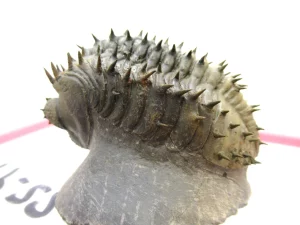
In the remote expanse of the Sahara Desert, amidst the arid and ancient landscape, a remarkable fossil discovery has emerged, shedding light on the enigmatic Drotops Armatus. Found nestled within the Middle Devonian layers atop Issoumour mountain, this extraordinary specimen captivates with its intriguing posture and pristine preservation.

Drotops Armatus, a species of trilobite from a bygone era, has astonished paleontologists and enthusiasts alike. What makes this discovery exceptional is not merely the species itself but the context in which it was found—near the peaks of Issoumour mountain, in a remarkable state of repose.

The unique positioning of the Drotops Armatus fossils offers a glimpse into their behavior and habitat. These ancient creatures, typically marine-dwelling, are thought to have rolled up and perished on these elevated terrains, preserving their form and structure in a manner rarely witnessed in the fossil record.

The geological wonders of the Sahara Desert, once an oceanic expanse teeming with life, now bear testimony to this extraordinary find. The Middle Devonian era, around 390 million years ago, saw these creatures thrive in ancient seas, their remains now entombed in the very peaks of Issoumour.

As researchers meticulously examine these fossilized trilobites, insights into their biology, evolutionary traits, and ecological interactions are unveiled. Their near-perfect preservation prompts speculation on the cataclysmic events that may have led to their entombment high in the mountains, a stark departure from their usual aquatic habitats.

.

.

The discovery of Drotops Armatus in such an unexpected locale sparks a resurgence in the study of prehistoric life in the Sahara. It underscores the importance of these remote and desolate regions as invaluable treasure troves of paleontological heritage, offering a rare window into ancient ecosystems and the evolutionary history of life on Earth.

.

As the exploration and analysis of these fossils continue, the saga of Drotops Armatus from the Middle Devonian unfolds, weaving a narrative of survival, adaptation, and eventual entombment that spans millions of years, ultimately gifting us a glimpse into a world long lost to time.